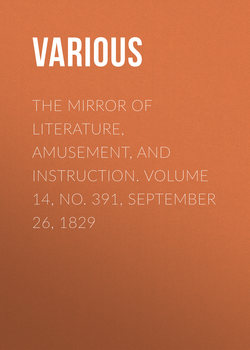The Mirror Of Literature, Amusement, And Instruction. Volume 14, No. 391, September 26, 1829

Реклама. ООО «ЛитРес», ИНН: 7719571260.
Оглавление
Various. The Mirror Of Literature, Amusement, And Instruction. Volume 14, No. 391, September 26, 1829
MR. GURNEY'S IMPROVED STEAM CARRIAGE
PUNNING SATIRE ON AN INCONSTANT LOVER
BRIMHAM ROCKS3 BY MOONLIGHT
MANNERS & CUSTOMS OF ALL NATIONS
PLEDGING HEALTHS
RUSSIAN SUPERSTITION
THE SELECTOR; AND LITERARY NOTICES OF NEW WORKS
LIBRARY OF ENTERTAINING KNOWLEDGE
SHAKSPEARE'S BROOCH
SPIRIT OF THE PUBLIC JOURNALS
NOTES ON THE DRAMA
BISHOPS' SLEEVES
SPIRIT OF DISCOVERY
THE GATHERER
ORIGIN OF THE WORD WORSTED
CAT-FANCIER
ANCIENT FAMILY
ON MEMORY
Отрывок из книги
Mr. Gurney, in perfecting this invention, has followed Dr. Franklin's advice—to tire and begin again. It is now four years since he first commenced his ingenious enterprise; and nearly two years since we reported and illustrated the progress he had made. (See MIRROR, vol. x. page 393, or No. 287.) He began with a large boiler, but public prejudice was too strong for it; and knowing people talked of high pressure accidents; the steam, could not, of course, be altogether got rid of, so to divide the danger, Mr. Gurney made his boiler in forty welded iron pipes; still the steam ran in a main pipe beneath the whole of the carriage, and the evil was but modified. At length the inventer has detached the engine and boiler, or locomotive part of the apparatus, which is now to be fastened to the carriage, and may be considered as a STEAM-HORSE, with no more danger than we should apprehend from a restive animal, in whose veins the steam or mettle circulates with too high a pressure. Fair trials have been made of the Improved Carriage on our common roads, the Premier has decided the machine "to be of great national importance," from sundry experiments witnessed by his grace, at Hounslow Barracks; and the coach is announced "really to start next month (the 1st) in working—not experimental journeys—for travellers between London and Bath."1 Crack upon crack will follow joke upon joke; the Omnibus, with its phaeton-like coursers will be eclipsed; and a journey to Bath and the Hot Wells by steam will soon be an everyday event.
Descriptions of Mr. Gurney's carriage have been so often before the public, that extended detail is unnecessary. Besides, all our liege subscribers will turn to the account in our No. 287. The recent improvements have been perspicuously stated by Mr. Herapath, of Cranford, in a letter in the Times newspaper, and we cannot do better than adopt and abridge a portion of his communication.
.....
"Now, from one of the experiments made in the barrack-yard, at Hounslow, I find we can approximate towards it. For instance, with one wheel only fixed to the 'carriers,' the carriage drew itself and load of water and coke (about 1 ton), with three men on it, and a wagon behind of 16 cwt. containing 27 soldiers. This, at the rate of 1-1/2 cwt. to a man, in round numbers is 4 tons. Estimating the force of traction of spring carriages at a twelfth of the total weight, it consequently gives a hold or bite on the road of 1-12 of 4 tons, or 6 2-3rds cwt. per wheel, or 13 1-3rd cwt. for the two wheels. This is likewise the propelling force of the carriage. Supposing, therefore, we were ascending a hill of 1 foot rise in 8, which I am assured exceeds in steepness any hill we have, we should be able to draw a load behind of 2 tons 2 cwt., or between 3 and 4 tons altogether....
"It has often been asserted that carriages of this sort could not go above 6 or 7 miles an hour. I can see no reasonable objection to 20. The following fact, decided before a large company in the barrack-yard, will best speak for itself:—At eighteen minutes after three I ascended the carriage with Mr. Gurney. After we had gone about half way round, 'Now,' said Mr. Gurney, 'I will show you her speed.' He did, and we completed seven turns round the outside of the road by twenty-eight minutes after three. If, therefore, as I was there assured, two and a half turns measured one mile, we went 2.8 miles in ten minutes; that is, at the rate of 16.8, or nearly 17 miles per hour. But as Mr. Gurney slackened its motion once or twice in the course of trial, to speak to some one, and did not go at an equal rate all the way round for fear of accident in the crowd, it is clear that sometimes we must have proceeded at the rate of upwards of twenty miles an hour."
.....